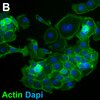The N terminus of the adhesion G protein-coupled receptor GPR56 controls receptor signaling activity.
Paavola, Kevin J, et al.
J. Biol. Chem., 286: 28914-21 (2011)
2011
Show Abstract
GPR56 is an adhesion G protein-coupled receptor that plays a key role in cortical development. Mutations to GPR56 in humans cause malformations of the cerebral cortex, but little is known about the normal function of the receptor. We found that the large N terminus (NT) of GPR56 is cleaved from the rest of the receptor during processing but remains non-covalently associated with the seven-transmembrane region of the receptor, as indicated by coimmunoprecipitation of the two GPR56 fragments from both transfected cells and native tissue. We also found that truncation of the GPR56 NT results in constitutive activation of receptor signaling, as revealed by increased GPR56-stimulated signaling upon transfection of HEK-293 cells with truncated GPR56, greatly enhanced binding of β-arrestins by truncated GPR56 relative to the full-length receptor, extensive ubiquitination of truncated GPR56, and cytotoxicity induced by truncated GPR56 that could be rescued by cotransfection of cells with β-arrestin 2. Furthermore, we found that the GPR56 NT is capable of homophilic trans-trans interactions that enhance receptor signaling activity. On the basis of these findings, we suggest a model of receptor activation in which the large N terminus of GPR56 constrains receptor activity but N-terminal interactions (GPR56 NT with an extracellular ligand and/or GPR56 NT homophilic trans-trans associations) can remove this inhibitory influence of the N terminus to activate receptor signaling. | 21708946
 |
















